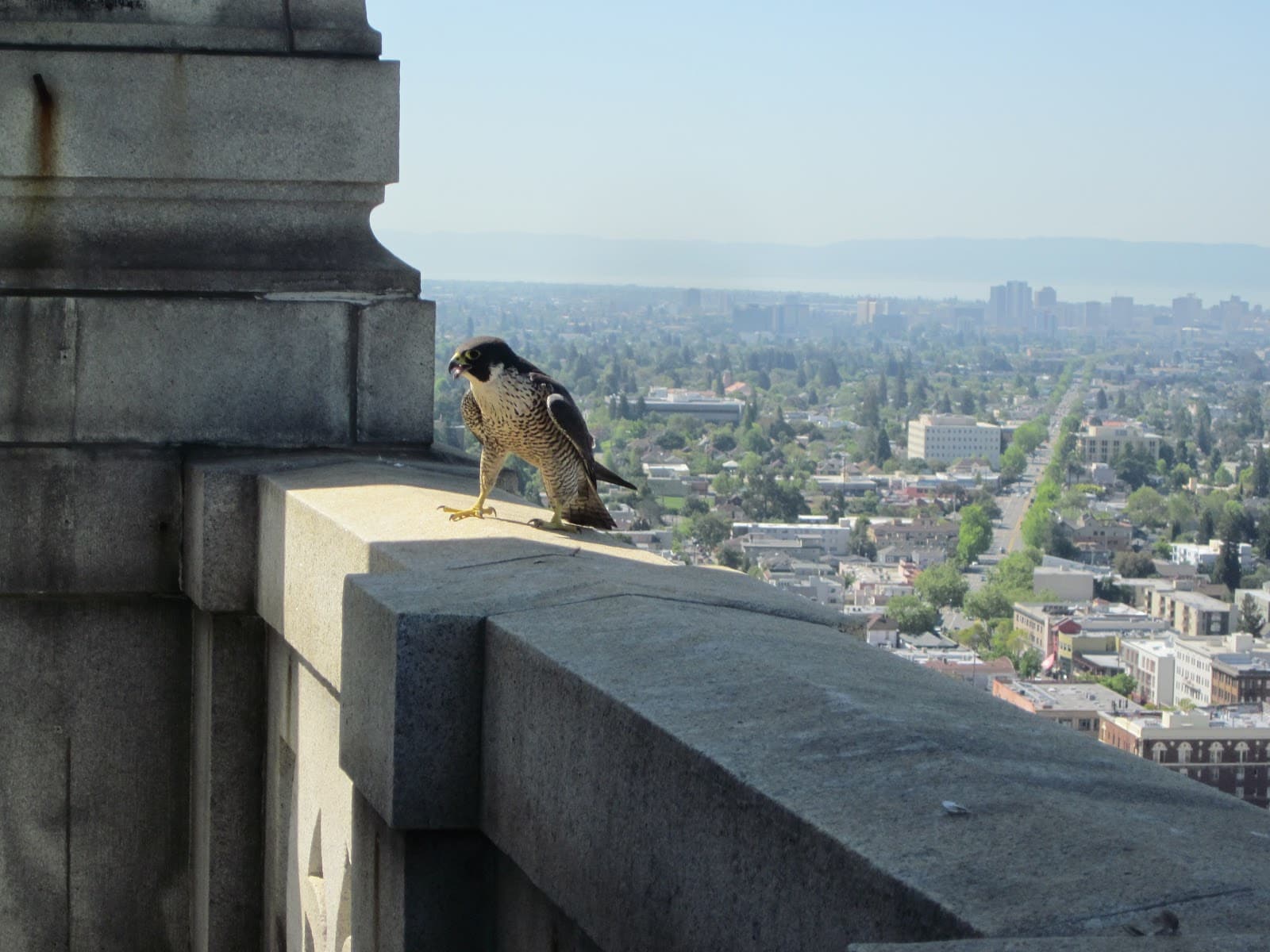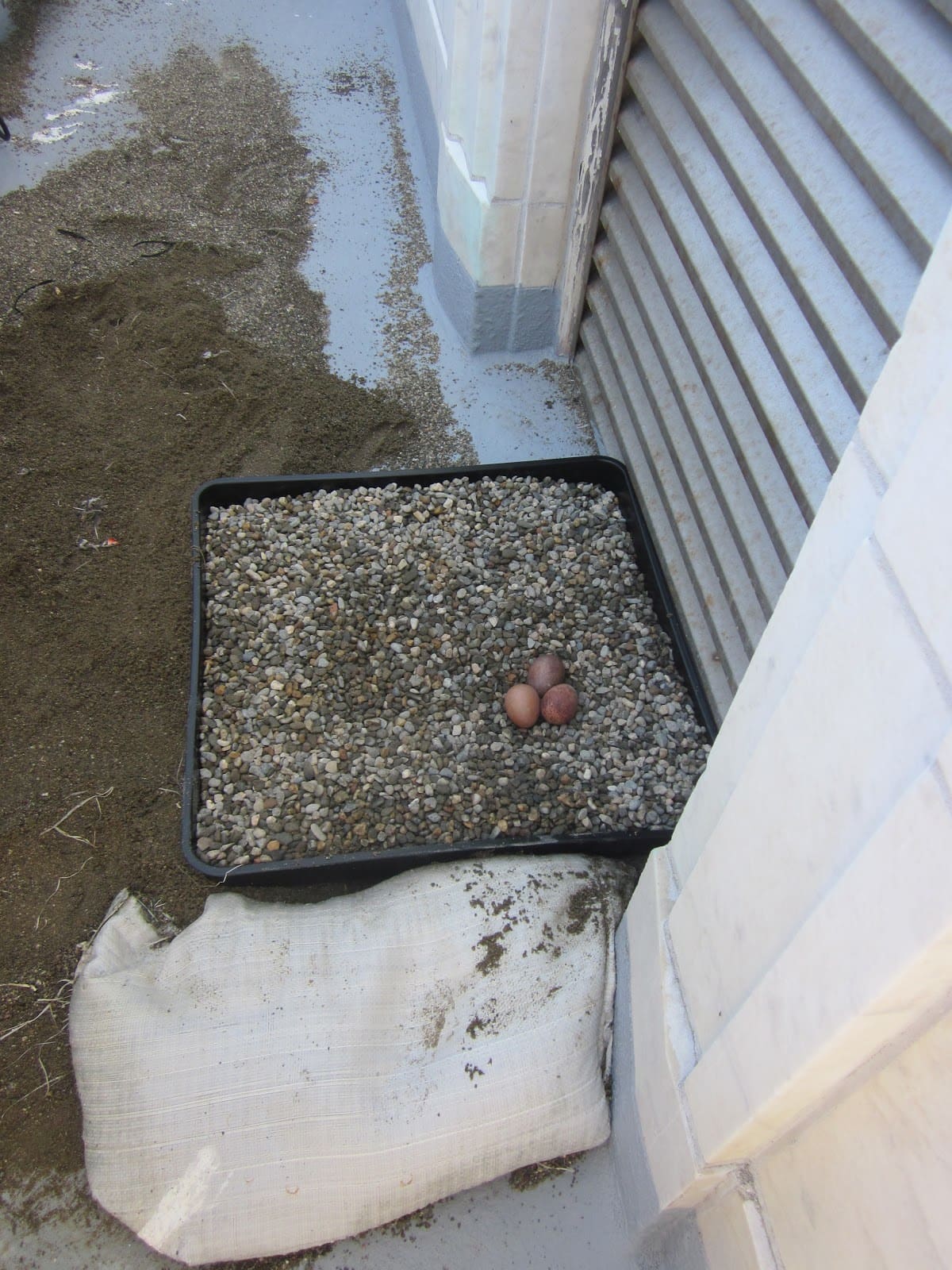This project is now in update mode. Check back regularly to see how things are progressing.
Campanile Peregrine Webcam
“THANK YOU!” to everyone for helping us reach and exceed our funding goal! We can now look forward to setting up a webcam system on the Campanile so everyone can watch the peregrines "Up close and Personal". We have created a new stretch goal of $16,000 to secure additional funds for maintenance and repair of the webcam system AND to hire a student intern for research, video archiving and preparing educational materials. Please join us in helping to reach our stretch goal. Thank you very much for all of your support!
Campanile Webcam: Get Up Close and Personal with UC’s Nesting Peregrine Falcons
Peregrine Falcons, the world’s fastest animal, were once on the brink of extinction. Due to the ubiquitous use of persistent pesticides such as DDT, California’s population of Peregrine Falcons declined from hundreds to just two known breeding pairs by 1970. Thanks to the tireless efforts of scientists, falconers, citizen scientists and academics, we now enjoy these truly magnificent birds as they reclaim not only their natural habitats but also new urban nest sites such as the UC Berkeley Campanile, where they were discovered in 2017 (Photo 1).

Realizing that the pair living on the Campanile did not have anything to nest on, we obtained emergency permission from state and federal authorities and UC Facilities Management to install a temporary nest shelf on the Campanile in 2017 (Photo 2).

To wide-spread interest, the pair of falcons hatched and raised two nestlings – later named after Berkeley’s motto in a campus-wide competition – Fiat and Lux. In 2018 we installed a permanent nest shelf on the Campanile for the falcons, which paid off when they successfully raised 3 nestlings! The 2018 nestlings were named in a campus-wide competition after three elements discovered at UC Berkeley, Berkelium, Californium and Lawrencium. All three juveniles learned to fly quickly and eventually left campus, with Lawrencium, the juvenile female, seen in the fall of 2018 at the Golden Gate Raptor Observatory in the Marin Headlands!
Although we have been monitoring the falcons from the ground using spotting scopes set-up near the Campanile for the past two years, the most common question we get from students is: “Is there a webcam?” Unfortunately, we cannot currently see the nest site on the upper balcony of the Campanile from the ground, so our observations are limited to the adult falcons until the juveniles are ready to fly. The goal of this campaign is to install a webcam so that everyone can enjoy and study UC Berkeley’s “own” peregrine falcons in real time and in much greater detail than through ground-based spotting scopes. With a webcam system, fans of UC Berkeley’s resident falcons will be able to peek in on the growing falcon family whenever they’d like. Researchers will be able follow the chronology of nesting without disturbing the falcons and determine exactly when the eggs are laid, hatching occurs and when to band the chicks. Will you make a gift today to help us purchase and install this webcam system?
The Campanile’s Peregrine Falcon webcam will advance research on urban nesting peregrines and document a host of key life-history and ecological parameters such as hatching success, prey base, and fledging success. The webcam will also be a tremendous benefit to UC Berkeley and the campus community and would highlight a great conservation success story in our own backyard.
Costs:
We hope to raise $10,141 total. This will cover the purchase of 2 pan-tilt/zoom cameras and associated equipment and installation costs ($8,172) plus 1-2 years maintenance ($1,969). We plan to place one camera in front of the nest shelf itself to have full view of the birds and a second camera in the northeast corner of the upper balcony. This will give us full views of three sides of the Campanile’s balcony to see not just the nest but the action and behavior of the falcons as they move about the tower. Thank you for your support!
Timeline:
We hope to move fast! We plan to install the webcams in December of this year to give the falcons plenty of time to get used to the system before mating and their first eggs are laid in early Spring.

Further Information:
This is a collaborative effort between UC Berkeley and the Museum of Vertebrate Zoology (www.mvz.berkeley.edu) (follow us on Twitter), the East Bay Regional Park District (www.ebparks.org), the Golden Gate Raptor Observatory (www.parksconservancy.org/programs/ggro) and the Institute for Wildlife Studies (www.iws.org).
Total Fundraising Goal: $10,141.00
includes:
Purchase and installation of webcam system: $8,172.00
One year maintenance of webcam system: $1,969.00
Budget Breakdown:
Peter Sharpe, Ph.D. (Institute for Wildlife Studies, PO Box 2500, Avalon, CA 90704; www.iws.org), will purchase, configure, and install the webcams and associated equipment. The total budget of $10,141.00 has two components: 1. purchase and installation of the webcam system ($8,172.00) and 2. maintenance of the system ($1,969.00). Budget 1 below covers the purchase, configuration, installation, and quality control of two pan/tilt/zoom cameras to monitor the peregrine falcon nest shelf on the west balcony of the Campanile and the north and east sides of the Campanile upper balconies. The latter would allow for observing the young falcon’s movement on the balcony after they have ventured out from the nest shelf. The upper balconies of the Campanile are closed to public access. The system would use power available on-site to power all equipment. One day of Dr. Sharpe’s time is allocated for equipment purchase and testing prior to installation, and two days of installation to allow for placing equipment on the UC Campanile and at a remote site if the video signal needs to be transmitted elsewhere. Based upon the photos of the clock tower, Dr. Sharpe proposes mounting 2”x 8” boards on the inside of the upper balcony railings using expandable rods attached to the boards so that there is no drilling into the building structure. This technique would 1) allow the cameras to be attached with no damage to the existing structure, and 2) keep the cameras and associated hardware hidden from view from the ground. Since the cameras would be facing the tower and situated at the level of the banisters, the cameras would not be able to pan out to the ground below the Campanile. Budget 2 below covers the cost of one year of maintenance of the system. One year of maintenance will provide time for fundraising future maintenance funds from other sources.

$25
Thank You + Enter Competition
For $25 or more, we will send an electronic photo card thank you, plus you may enter a competition to name the adult peregrines (pool of names will be considered by the Fund Raising Team).
$100
Photo of a Peregrine
With $100 or more donation, you will receive a beautiful photo of a peregrine falcon taken by Mary Malec.
$200
Join Our Fledge-Watch Team
A $200 contribution will get you a personalized visit with our Fledge-watch Team. This will include viewing the peregrines on the Campanile through a scope and a history of these nesting peregrines. Visit will take place during nesting season.
$500
Watercolor Painting from Mary
For $500 donation, you will receive a watercolor painting of a beautiful peregrine falcon feather. Artist: Mary Malec
$1,000
Personal Museum Tour
For a $1,000 donation, you will receive a personal tour for up to four people of the Museum of Vertebrate Zoology with Carla Cicero, Staff Curator of Birds OR, a tour of Golden Gate Raptor Observatory with Allen Fish, Director (choice of contributor).
$1,500
Birding Field Trip
General birding field trip with Sean Peterson in East Bay Regional Parks OR, visit to a different urban peregrine nest site with Mary Malec/Doug Bell OR visit to a well-known natural peregrine nest site with Mary Malec/Doug Bell to observe nesting peregrines from a safe distance without disturbing them (choice of contributor).
$2,000
Watercolor Painting from Lynn
For a contribution of $2,000 or more, you will receive a watercolor painting of a peregrine falcon from the artist, Lynn Schofield.






